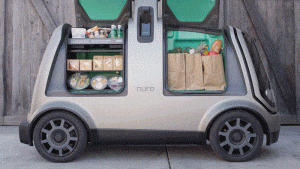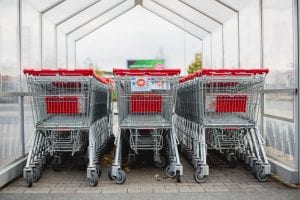By Rick Stein, Principal and Owner of Urban Decision Group
The largest grocery chain in the U.S. recently announced they are testing driverless grocery delivery in Scottsdale, Arizona. In the U.S., The Kroger Company is the Walmart/Amazon of the grocery sector. In other words, this is a big deal. We’ve spent a lot of time discussing the impacts of AV on the transport of humans, but the earliest, and arguably the most profound impacts, will occur because of rapidly changing consumer expectations.

Kroger’s pilot program currently uses an autonomous Prius with a human in the driver’s seat to monitor the car’s performance, but future versions of this service will be completely autonomous. Kroger is partnering with Nuro, a startup founded by two Google engineers who worked at Google’s Waymo venture. During this pilot phase, a clerk loads the groceries into the vehicle and then the vehicle delivers the groceries to the customer at their curb where the customer enters a numeric code to open the vehicle. These are baby steps towards the inevitable – the complete automation of the entire process from ordering to stocking the food pantry in your home. And oh, by the way, the entire supply chain will be automated as well. It’s time to make friends with our robot overlords.
This past March, I and two of my colleagues traveled to Portland for the inaugural Urbanism Next Conference where we gave a presentation in which we speculated that the retail industry will likely be the earliest, and most significant adopters of autonomous vehicle technology. The presentation was well-received and even got some love from the folks at The Atlantic’s CityLab. At the time, we told those in attendance to prepare for the one-hour delivery of virtually anything within three years or so. A series of recent acquisitions and partnerships undertaken by The Kroger Company seems to validate the ambitious goals of automating the entire grocery procurement process. While the timeline for achieving these goals will be impacted by factors such as regulations (including zoning), technology, safety, and the economy, to name a few – make no mistake, it’s coming.
Up until now, all you really needed to do was pay attention to the seemingly daily barrage of articles about Amazon and Walmart competing for the consumer’s attention. Now we can throw Kroger into the mix as well. Obviously, there will be other retailers that embrace autonomy in the next couple of years – many, many others. The battle to bring goods to the market for the lowest price has long been the goal of the largest retailers, but prices can only go so low before producing a good stops making sense. The war on price isn’t over, but it is going to take a back seat to the next epic fight – the battle over your time. And this war will be ugly if we aren’t prepared for it.
In 2005, Amazon introduced us to Amazon Prime – a membership-based service that promised free two-day shipping on eligible purchases within the contiguous United States. Within a few years, we will likely reflect on Amazon Prime as a cute idea. From this point forward, the consumer’s “time” is squarely the target of the world’s largest retailers. While a lot of attention is paid to the concept of “experiential retail” as a means of saving conventional brick and mortar retail, the battle over our time will have a much larger impact on us all, regardless of our level of consumerism.
Amazon is currently rolling out a two-hour delivery service from Whole Foods through Prime Now. Prime Now does not use autonomy/robotics/AI and it is only for items stocked at Whole Foods. Rest assured, future versions of Prime Now will almost certainly employ all those inter-related technologies and will extend way beyond grocery items. Each of the major retailers will try to one-up each other to deliver goods to us as fast as is technologically possible. What does this mean for our cities? Well, it means cities need to be prepared for a level of disruption not seen since the widespread adoption of the automobile and the post-World War II demand for housing produced the modern suburb.

There are going to be autonomous delivery vehicles on our roads – a lot of them. You could make the argument that if I purchase goods online and the goods are delivered to me (autonomously or not), then aren’t I simply substituting my trip with another’s trip? In theory this is true, but we have evidence in the form of humankind’s relatively recent adoption of computing technology, that we don’t merely substitute one thing for another; rather, we tend to add additional tasks into the voids created by technologically-enabled efficiency. For example, the adoption of electronic spreadsheets reduced the amount of time to complete most accounting tasks. Calculations that took hours or days to complete could now be done in a matter of minutes or seconds. Employers took advantage of that time savings and added more and more tasks. Smart phone adoption is a more recent example of a tool that made us more efficient on one hand, but somehow resulted in us being even more busy than before. It stands to reason that if we chose to have most things delivered to us, we will use our newfound time to do something else – and that something else may very well be taking a trip somewhere – perhaps a trip to an experiential retailer.
How are we going to deal with all these extra vehicles on our streets and roads? We don’t have the space or the money to build our way out of it. Not to mention, there is no evidence that it is even possible to build your way out of traffic congestion in the long run. Further, we haven’t even talked about the inevitability of existing physical retail buildings functioning as distribution nodes and the challenges this presents to existing zoning. That is another conversation for another blog post (or book).
The takeaway is this – our cities are ill-prepared to handle the disruption that is coming their way. The “solutions” are going to be complicated and will impact everything from zoning to transportation funding. Although cities are on the front lines, this will require an “all hands on deck” approach that includes regional, state, and federal coordination. The way we manage autonomous delivery of retail goods will likely be an indicator of our ability to manage the autonomous delivery of humans. It’s the proverbial canary in the coalmine.


Perhaps. Perhaps not. The conclusions reached in this article are, for the most part, unsupported. Lots of speculation but little more than opinion.